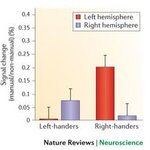Neuroscience

David Perlmutter, MD, became well-known last year as the best-selling author of Grain Brain, which demonizes wheat (and, of course, gluten) and he recently claimed that simple dietary changes would prevent half of Alzheimer's cases.
His claims lack what we might consider an ethical barometer. If you and I read 'possible association' in a paper that was based on 13 people, we know it means there is a curve that matches in a small study, but that isn't causation. Perlmutter found that same paper and declared the science was settled and that denying it was a Vast Conspiracy to keep us over…

Jazz musicians do a lot of spontaneous, improvisational music and brains scans show robust activation of brain areas traditionally associated with spoken language and syntax, which are used to interpret the structure of phrases and sentences.
But this musical conversation shut down brain areas linked to semantics — those that process the meaning of spoken language, according to results of a new study by Johns Hopkins researchers which used functional magnetic resonance imaging (fMRI) to track the brain activity of jazz musicians in the act of "trading fours," a process in which musicians…

Some people don't remember dreams at all while some remember them frequently. What separates them?
Images in brain scans, at least, though that may lead to a more meaningful answer also.
A team led by Perrine Ruby, an Inserm Research Fellow at the Lyon Neuroscience Research Center (Inserm/CNRS/Université Claude Bernard Lyon 1), has studied the brain activity of these two types of dreamers in order to understand the differences between them.
In an imaging study, the researchers find that the temporo-parietal junction, an information-processing hub in the brain, is more active in high…

The anterior insula region deep inside the brain controls how quickly people make decisions about love, according to a new paper.
The finding, made in an examination of a 48-year-old man who suffered a stroke, is the first causal clinical evidence that the anterior insula "plays an instrumental role in love," according to Stephanie Cacioppo, Director of the Center for Cognitive and Social Neuroscience Laboratory of the University of Chicago, lead author of the study who also helped create an evolutionary theory of loneliness.
In an earlier paper on the topic, Cacioppo and colleagues defined…

Everyone feels neuroscience studies are biased, no matter how representative they try to be. But Roel Willems and colleagues from the Donders Institute for Brain, Cognition and Behaviour at Radboud University Nijmegen,
and Max Planck Institute in Nijmegen say studies are flawed if they don't include enough left-handed people.
Because left-handed people have different brains.
Of course, everyone has different brains, the issue in studies is whether or not the difference is meaningful and can easily be controlled for in data. The authors of a new paper in Nature Reviews…

Can data be a tactile experience?
The CEEDs project thinks it can be, and they want to use integrated technologies to support human experience when trying to make sense of very large datasets.
Jonathan Freeman Professor of Psychology at Goldsmith University of London, did an interview with youris.com to outline how they believe this project can help present data better, depending on the feedback participants provide to data from their environment via monitoring of explicit responses such as eye movement, and their inner reactions, like rate.
What inspired you to get involved in…

The autism community agrees that autism has its origins in early life—fotal and/or postnatal.
A team led by Yehezkel Ben-Ari, Inserm Emeritus Research Director at the Mediterranean Institute of Neurobiology (INMED), has made a breakthrough in the understanding of the disorder. In an article published in Science, the researchers demonstrate that chloride levels are elevated in the neurons of mice used in an animal model of autism, and remain at abnormal levels from birth.
These results corroborate the success obtained with the diuretic treatment tested on autistic children by the researchers…

Symmetry isn't always good. When we look at human faces, the most symmetrical, where one half is mirrored to the other, are less attractive than faces that show some distinction.
And it isn't just culture. A study in brains found that too much symmetry is also bad. Fish that have symmetric brains show defects in processing information about sights and smells, according to a new paper
in Current Biology.
It's widely believed that the left and right sides of the brain have slightly different roles in cognition and in regulating behavior, but whether or not these asymmetries actually…
We're all capable of committing violence. The person who truly cannot commit violence is quite rare, and likely learned it. Some aspects of behavior depend on interactions in the brain between genetic and environmental factors.
And so, it is said, an individual may be more vulnerable to developing violent behaviors if they have predisposing factors and then undergo stress, abuse, or other triggers, especially early in life. Neurobiologists have also documented numerous examples of sex differences in the human brain, including differences in brain regions and circuits relevant to…

A new study found that the ability to follow another's gaze or look in the direction someone is pointing, two examples of receptive joint attention, is significantly heritable.
Determining such communicative cues are significantly heritable means variation in this ability has a genetic basis, the authors say, which has led them to the vasopressin receptor gene, known for its role in social bonding.
They are looking for insight into the biology of disorders in which receptive joint attention is compromised, such as autism spectrum disorders (ASD), which could lead to new diagnosis and…